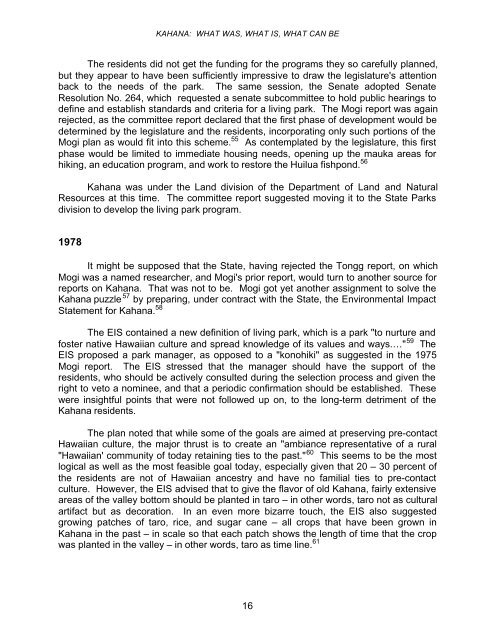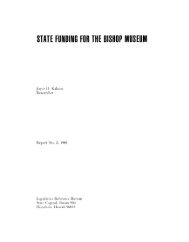Kahana: what was, what is, what can be. - Legislative Reference ...
Kahana: what was, what is, what can be. - Legislative Reference ...
Kahana: what was, what is, what can be. - Legislative Reference ...
Create successful ePaper yourself
Turn your PDF publications into a flip-book with our unique Google optimized e-Paper software.
KAHANA: WHAT WAS, WHAT IS, WHAT CAN BE<br />
The residents did not get the funding for the programs they so carefully planned,<br />
but they appear to have <strong>be</strong>en sufficiently impressive to draw the leg<strong>is</strong>lature's attention<br />
back to the needs of the park. The same session, the Senate adopted Senate<br />
Resolution No. 264, which requested a senate subcommittee to hold public hearings to<br />
define and establ<strong>is</strong>h standards and criteria for a living park. The Mogi report <strong>was</strong> again<br />
rejected, as the committee report declared that the first phase of development would <strong>be</strong><br />
determined by the leg<strong>is</strong>lature and the residents, incorporating only such portions of the<br />
Mogi plan as would fit into th<strong>is</strong> scheme. 55 As contemplated by the leg<strong>is</strong>lature, th<strong>is</strong> first<br />
phase would <strong>be</strong> limited to immediate housing needs, opening up the mauka areas for<br />
hiking, an education program, and work to restore the Huilua f<strong>is</strong>hpond. 56<br />
<strong>Kahana</strong> <strong>was</strong> under the Land div<strong>is</strong>ion of the Department of Land and Natural<br />
Resources at th<strong>is</strong> time. The committee report suggested moving it to the State Parks<br />
div<strong>is</strong>ion to develop the living park program.<br />
1978<br />
It might <strong>be</strong> supposed that the State, having rejected the Tongg report, on which<br />
Mogi <strong>was</strong> a named researcher, and Mogi's prior report, would turn to another source for<br />
reports on <strong>Kahana</strong>. That <strong>was</strong> not to <strong>be</strong>. Mogi got yet another assignment to solve the<br />
<strong>Kahana</strong> puzzle 57 by preparing, under contract with the State, the Environmental Impact<br />
Statement for <strong>Kahana</strong>. 58<br />
The EIS contained a new definition of living park, which <strong>is</strong> a park "to nurture and<br />
foster native Hawaiian culture and spread knowledge of its values and ways.…" 59 The<br />
EIS proposed a park manager, as opposed to a "konohiki" as suggested in the 1975<br />
Mogi report. The EIS stressed that the manager should have the support of the<br />
residents, who should <strong>be</strong> actively consulted during the selection process and given the<br />
right to veto a nominee, and that a periodic confirmation should <strong>be</strong> establ<strong>is</strong>hed. These<br />
were insightful points that were not followed up on, to the long-term detriment of the<br />
<strong>Kahana</strong> residents.<br />
The plan noted that while some of the goals are aimed at preserving pre-contact<br />
Hawaiian culture, the major thrust <strong>is</strong> to create an "ambiance representative of a rural<br />
"Hawaiian' community of today retaining ties to the past." 60 Th<strong>is</strong> seems to <strong>be</strong> the most<br />
logical as well as the most feasible goal today, especially given that 20 – 30 percent of<br />
the residents are not of Hawaiian ancestry and have no familial ties to pre-contact<br />
culture. However, the EIS adv<strong>is</strong>ed that to give the flavor of old <strong>Kahana</strong>, fairly extensive<br />
areas of the valley bottom should <strong>be</strong> planted in taro – in other words, taro not as cultural<br />
artifact but as decoration. In an even more bizarre touch, the EIS also suggested<br />
growing patches of taro, rice, and sugar <strong>can</strong>e – all crops that have <strong>be</strong>en grown in<br />
<strong>Kahana</strong> in the past – in scale so that each patch shows the length of time that the crop<br />
<strong>was</strong> planted in the valley – in other words, taro as time line. 61<br />
16
















